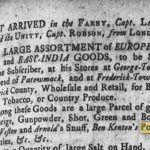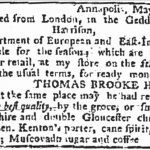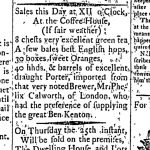 Hunting for references to the 1700s hops trade, I came upon this notice in the Independent Journal of New York from 1 March 1784. What was remarkable was how, within a year of the end of the American Revolution, trade was being undertaken with the former motherland. What was also remarkable “Ben Kenton’s Porter” – who was he? Two and a half years ago, I mentioned Hibbert’s London Porter being sold in New York in 1798 but have yet to see this Kenton follow mentioned. Now off on a new hunt, I found the following in a book from 1787 entitled Adventures of Jonathan Corncob, Loyal American Refugee:
Hunting for references to the 1700s hops trade, I came upon this notice in the Independent Journal of New York from 1 March 1784. What was remarkable was how, within a year of the end of the American Revolution, trade was being undertaken with the former motherland. What was also remarkable “Ben Kenton’s Porter” – who was he? Two and a half years ago, I mentioned Hibbert’s London Porter being sold in New York in 1798 but have yet to see this Kenton follow mentioned. Now off on a new hunt, I found the following in a book from 1787 entitled Adventures of Jonathan Corncob, Loyal American Refugee:
A few minutes after a gentleman came up to me, and asked me if my name was not Corncob; I answered in the affirmative, but said I had not the honour of-recollecting him. “I wonder at that,” said he, “for we were fellow prisoners at Boston, and made our escape together from gaol.” We immediately began to congratulate and compliment each other… On taking leave he invited me to dine with him the following day, at his plantation, where I was regaled in a most luxurious manner; the turtle was superior to any ever served on a lord mayor’s table; the’oranges and pine-apples were of the highest flavour; Ben Kenton’s porter sparkled like champaign, and excellent claret and Madeira crowned the feast. At the end of the dinner I caught myself unbuttoning my waistcoat, and crying out, ’tis d–d hard that there should be hurricanes in this country.
Then, my curiosity piqued by mention of the quality, I found this passage in the diary Of Joseph Farington, R.A. from September 1803:
September 4. Dance called. He spoke of the great changes which happen in some men’s fortunes. He dined the other day with Claude Scott, the corn merchant at His House near Bromley where He lives splendidly. The late Ben Kenton ; Porter Seller & Wine merchant told Dance that when he kept the Magpye ale house in Whitechapel, Claude Scott, abt. 30 years ago, applied to him offering to keep his books, being then seeking for employment. Kenton died possessed of a great fortune, & Scott is supposed to be worth 300,000. His Son married the only daughter of a Mr. Armstrong who is said to be worth half a million.
Greedy Georgians. It’s all money, money, money with them. Kenton was described in one account as “a typical East End lad made good; his mother was said to have sold cabbages on a stall in Whitechapel Field Gate.” Kenton himself apparently started out as a waiter in a tavern. In The Annual Register, Or, A View of the History, Politics, and Literature for the Year 1800, Kenton’s passing was recorded in this entry for 25 May:
In Gower-street, in his eighty-third year, Benjamin Kenton, esq. From an obscure origin, and an education in a charity-school, he obtained, by frugality, industry, and integrity, with an irreproachable character, a more than princely fortune. For some years, he kept the Crown and Magpye tavern, in Whitechapel; and afterwards, becoming wine-merchant in the Minories,* He went very largely into the trade of exporting porter. His property, in the different public funds, exceeds 300,000l. and at the present market prices, is worth 272,000l. his landed estates 680l. a year. And he has bestowed it in a manner that reflects honour to his memory.
Kenton’s portrait hangs in Vintners’ Hall in London. He was “one of the most of distinguished members” of the Vintners’ Company was one of the beneficiaries under his will. His obituary goes on to list all the charities to which he left considerable sums – “the hospitals of Christ, St. Bartholomew, and Bethlehem, 5000l each; to the charity for the blind, 20,000l” as well as one Mr. Smith, his grandson, and only immediate descendant, “who was, unfortunately, not much in his favour 800l a year.” Don’t shed a tear as that is the equivalent of 87,000 pounds a year now. The vast residue of the estate is left to his daughter’s man friend, survivor of a bit of a tragic tale. **Anyway, so it appears Kenton was a self made man with buckets of money. Made from selling wine and Porter.
Before he was a disgruntled schismist, Anglophile George Washington bought Kenton’s porter as part of a large general shipment of fine British goods in 1760.*** Here is a 1766 invoice for a shipment sent by Kenton to the Worshipful Company of Clothworkers.
To the left is an advertisement from the Maryland Gazette of 28 July 1763 offering “Ben Kenton’s Porter in bottles.” From the same publication, in the middle there is a notice from 19 May 1774 which includes among the offerings “a few dozen of Ben Kenton’s porter.” To the right is word of a sale in the 12 March 1784 Morning Post of New York with 40 barrels and hogsheads of porter which was not from Ben Kenton but direct from the brewer Phelix Calworth “who had the preference of supplying the great Ben Kenton.” Which points out that Kenton made his zillions not from making the porter but from distributing it. Kenton’s middleman role is similar to the one played by the merchants Hugh & Alexander Wallace in 1772 intra-provincially as shippers of Lispenard’s beer to William Johnson, the man who could have stopped Washington had he lived.
Detail on his rise to wealth and how it occurred is set out in an 1893 guide to London street signs:
In the year 1719 a boy was born of humble parentage in Whitechapel, who, as Benjamin Kenton, vintner and philanthropist, achieved a considerable reputation. He was educated at the charity school of the parish, and in his fifteenth year apprenticed to the landlord of the Angel and Crown in Goulston Street, Whitechapel. Having served his time, he became waiter and drawer at the Crown and Magpie in Aldgate High Street, not long since pulled down. The sign was a Crown of stone and a Magpie carved in pear-tree wood, and the house was frequented by sea captains. Kenton’s master is said to have been among the first who possessed the art of bottling beer for warm climates. He, without reason, changed the sign to the Crown; his custom fell off; he died, and the concern came into the hands of Kenton, who restored the Magpie to its former position, and so increased the bottled-beer business, that in 1765 he gave up the tavern and removed to more commodious quarters which he built in the Minories.
Hmm: “…among the first who possessed the art of bottling beer for warm climates.” It is noted in the guide Cylindrical English Wine and Beer Bottles 1735-1850 that Kenton took care to select the design of his glassware, preferring champagne style glass. Kenton shipped bottled porter to India, too.
The bottles were good enough to steal, in fact. In the records from the Old Bailey, there is a prosecution of William Sinkey for the 1780 theft of three baskets of empty bottles owned by Kenton. The finding of “not guilty” was based on Sinkey’s argument that the thief had been hired by someone to carry the basket he was found with. Seems a bit light to be let off if you ask me. By contrast, in 1771 William Grimsby – a cooper by trade – was found rolling away a hogshead owned by Kenton just 40 yards down the road from where it was left. He was not so lucky in his pleas to the court, was convicted and transported. The thief was likely sent to America, the main repository before the Revolution and before convicts were sent to Australia.
More than just biography makes this all of interest. It reminds me of the 1700s hop rulings I wrote about a few years ago that indicates how much value was in that element of the brewing industry. Scale. The economic power that brewing generates never fails to impress. I am also very intrigued by the reference to the “art of bottling beer for warm climates.”****We see again and again how common trans-oceanic shipments of porter, ales and beer were. That the skill was perfected by a wine and porter merchant perhaps should have been obvious in hindsight. Have to keep seeing what I can find out about what that skill was…
*His business address in 1760 was No. 152, the Minories, Aldgate according to a note to this record of Washington’s purchase. This blog post has an image of the street from not long after Kenton’s passing.
**Who, in turn, appears to be uncle to the painter Constable.
***He bought from Kenton regularly in the 1760s. His taste for porter extended past the Revolution.
****Note => “He… became possessed of a secret which made his fortune, that of bottling ale so that it could pass through the changes of climate on the voyage to India round the Cape, without the cork flying out of the bottle.”




‘Phelix Calworth’ is presumably Felix Calvert of the Hour Glass brewery.
Excellent – although there are apparently many Felix Calverts to choose from!